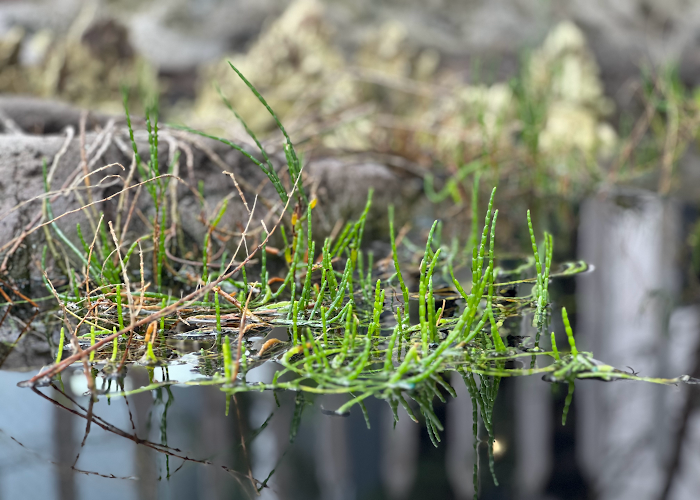When’s the last time you took a stroll through our Saltmarsh Aviary? Picture the warm, gentle breeze and the beautiful sunny weather. A signature palmetto tree fans over you, and the sight of marsh cordgrass, a staple of the Lowcountry landscape, surrounds you. Among these well-known coastal species of plants, a new species is sprouting up near the entrance: a small but mighty crop of vibrant green sea beans! Sure, they’re a sight to see, but did you know they’re also tasty, healthy AND help fight climate change?
These small succulents are a species of halophyte — or salt-tolerant plant — scientifically known as Salicornia, and can be found in the saltmarsh, along coastlines or in mangrove forests across the globe. If you’ve been on the water around the Lowcountry by boat, kayak or paddleboard, chances are you’ve passed by them, too.
 Sea beans can be found in mangrove forests.
Sea beans can be found in mangrove forests.Many Identi-seas
Pickleweed, sea asparagus, samphire, glasswort, saltwort… these are the many identities of the 53 species of this popular salty halophyte. Just like their many names, sea beans have had many uses in our history. One of their original names, glasswort, came from the 16th century when the plant was collected to make powdered sodium carbonate (soda ash) by burning off the fleshy parts and evaporating leftover water. The soda ash was then used to make glass or detergent. Modern day use of sea beans is much more straightforward (and delicious)!
Spill the Beans
The saltmarsh is transitional area of land that protects inland habitats from the effects of storms and tidal surge. Saltmarsh plants, such as sea beans and marsh grasses, build up this habitat. Ultimately, this protects us and everything we love. Similar to marsh cordgrass, sea beans thrive in hot, wet, salty and humid environments, resistent to saltwater inundation and high temperatures. Regardless of whether we have rising tides or drought conditions, sea beans are hardy enough to survive the changing climate, allowing us to have a stable, nutrient-rich source for protection and for our palates!
 The saltmarsh is vital to coastline protection.
The saltmarsh is vital to coastline protection. Have Your Beans and Eat Them Too
What’s another benefit to adding sea beans to your diet? They‘re farmed locally and sustainably! You could forage for sea beans in the wild if you so desired, but purchasing them from a local farmer who coordinates efforts to restore the saltmarsh, such as Heron Farms, or looking for dishes that incorporate this local delicacy is easy and you can feel good about your decision! Among the many nutrients packed into this tiny plant, they are a vegan source of Omega-3, the same fatty acid that is in fish, seeds and nuts! If that wasn’t enough reason to run out and buy some to include in your next meal, sea beans are also a rare source of sea minerals that aren’t found easily in everyday options.
Speaking of which, here are a few ways you can incorporate sea beans into your next meal (but watch out for their strong, salty taste!):
- Mince into small pieces and use instead of table salt
- Garnish your Lowcountry seafood with a sprig of sea bean
- Blanch and eat as a side dish with any meal
- Muddle and add to a cocktail
- Bake sprigs into bread or on top of focaccia
- Cook into any pasta recipe for an added nutrient boost
 Pictured are sea beans roasted with golden potatoes.
Pictured are sea beans roasted with golden potatoes.Come Sea the Beans
Sea beans are unique and resilient, making a huge impact on our environment and on our own ability to take action in the face of climate change. Want to see sea beans up close so you can easily spot them in the Lowcountry later on? Visit us and stop by the Saltmarsh Aviary to learn more!
Published January 9, 2023


